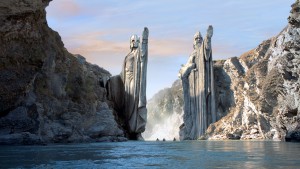 This is a very cool, very interesting Middle-earth history lesson wrapped into a list of its seven greatest architectural wonders. I find myself hard-pressed to disagree with any of the author’s choices. The ancient Dwarven cities of Nogrod and Belegost — and even Erebor — paled in comparison to Khazad-dûm’s lost glory.
This is a very cool, very interesting Middle-earth history lesson wrapped into a list of its seven greatest architectural wonders. I find myself hard-pressed to disagree with any of the author’s choices. The ancient Dwarven cities of Nogrod and Belegost — and even Erebor — paled in comparison to Khazad-dûm’s lost glory.
Perhaps, at its peak, Osgiliath’s grandeur might have outstripped that of Minas Anor, but it lacked Minas Anor’s mountainous, physics-defying scale. The strange Pukel Men of Dunharrow might offer another option. And what of Thangorodrim and Angband, Morgoth’s fortresses from the First age and earlier? Would they have been mightier than Barad-dûr?
Anyway, have a read and add your thoughts in the comments. I’d encourage you to follow the links and read the full (and very extensive) entries on each wonder!
The seven structural wonders of Middle-earth
by Barahir-(V)
Many are the great structures in Middle-earth, some tall and majestic, some dark and monstrous, some fair and captivating. Built by Elves, Dwarves, Men and even Orcs, seven truly stand out not only as the great structures of their age, kingdom and kind but were wondrous; making those who beheld them, whether friend or foe or critic, consider how they were built, who was so inspired to build them, the incredible but wondrous labours to build them, who was so heartless as to destroy them, and, for most, how could they have withstood the siege of time, the malice of evil and corruption of change?
Here are the reasons why the author has chosen these as the Seven Structural Wonders of Middle-earth:
Number 7: The Argonath.
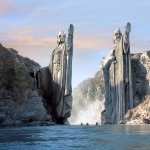 The Pillars of the Argonath are described as statues, yet these are not just any stone carving but colossal and lofty grey stone statues carved in the likeness of Isildur and Anarion, the sons of Elendil, on the two sides of the river Anduin near the central part of Middle-earth. These statues are one of the very, very few Third Age structures of magnificence. They were not built by Isildur or Anarion or Elendil but by the regent Minalcar, according to the ‘Appendix’ [Lord of the Rings]. It was built after Gondor prevailed over the Haradrim in TA 1248 as a token of Gondor’s supremacy not only in its military might but in its architectural skills.
The Pillars of the Argonath are described as statues, yet these are not just any stone carving but colossal and lofty grey stone statues carved in the likeness of Isildur and Anarion, the sons of Elendil, on the two sides of the river Anduin near the central part of Middle-earth. These statues are one of the very, very few Third Age structures of magnificence. They were not built by Isildur or Anarion or Elendil but by the regent Minalcar, according to the ‘Appendix’ [Lord of the Rings]. It was built after Gondor prevailed over the Haradrim in TA 1248 as a token of Gondor’s supremacy not only in its military might but in its architectural skills.
Number 6: Isengard.
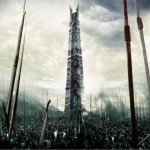 Isengard is one of the classical Númenórean constructions built by none other than Anarion and Isildur at the end of the Second Age. It is also an example of the classical wonders of Middle-earth, and of all the wonders of Middle-earth, only Minas Anor (Tirith) has been fully treated in the Lord of the Rings (LOTR). It’s a marvel in its construction, a wonder in its materials and a sight to behold. Isengard is a ring of rocks with a single gate at the south end, built between the two mountains at the southern end of the Misty Mountains. These rocks do not look like any construction of Men but the product of time on the upheaval of the hills.
Isengard is one of the classical Númenórean constructions built by none other than Anarion and Isildur at the end of the Second Age. It is also an example of the classical wonders of Middle-earth, and of all the wonders of Middle-earth, only Minas Anor (Tirith) has been fully treated in the Lord of the Rings (LOTR). It’s a marvel in its construction, a wonder in its materials and a sight to behold. Isengard is a ring of rocks with a single gate at the south end, built between the two mountains at the southern end of the Misty Mountains. These rocks do not look like any construction of Men but the product of time on the upheaval of the hills.
Number 5: Barad-dûr.
 Dark as the night, terrible as the storm, fierce as the flame and impregnable as the earth stood one of the Dark Lord’s greatest creations, the Barad-dûr. Of all the great things created by the Lord of the Rings, Sauron, servant of Morgoth, Barad-dûr was the greatest, perhaps greater even than the One Ring but built with the immeasurable labour of the Orcs. Its construction was started in TA c.1000 and finished TA c.1600 as the defence of Sauron against the forces of Númenór. It took many years, for its construction and its foundation were built with the power of the One Ring making its fate bound with the Ring.
Dark as the night, terrible as the storm, fierce as the flame and impregnable as the earth stood one of the Dark Lord’s greatest creations, the Barad-dûr. Of all the great things created by the Lord of the Rings, Sauron, servant of Morgoth, Barad-dûr was the greatest, perhaps greater even than the One Ring but built with the immeasurable labour of the Orcs. Its construction was started in TA c.1000 and finished TA c.1600 as the defence of Sauron against the forces of Númenór. It took many years, for its construction and its foundation were built with the power of the One Ring making its fate bound with the Ring.
Number 4: Minas Anor.
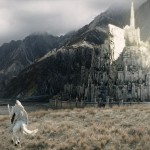 Minas Anor, more commonly known as Minas Tirith, is one of the most astounding pieces of architecture built by Men if not the greatest work of architecture by Men. Its name is translated as the “Tower of the Setting Sun” and for the latter, it is translated as the “Tower of the Guard”, but the word Citadel would have better suited it than tower. It was built by the exiled Numenoreans at the very edge of the White Mountains, at the very foot of Mount Mindolluin, in the vale of the Anduin in the year SA 3320 by Anarion. It must have taken great innovation, engineering, skill and determined builders with excellent tools to build such an ambitious structure. It would have been very interesting to meet to the impresario of the whole construction.
Minas Anor, more commonly known as Minas Tirith, is one of the most astounding pieces of architecture built by Men if not the greatest work of architecture by Men. Its name is translated as the “Tower of the Setting Sun” and for the latter, it is translated as the “Tower of the Guard”, but the word Citadel would have better suited it than tower. It was built by the exiled Numenoreans at the very edge of the White Mountains, at the very foot of Mount Mindolluin, in the vale of the Anduin in the year SA 3320 by Anarion. It must have taken great innovation, engineering, skill and determined builders with excellent tools to build such an ambitious structure. It would have been very interesting to meet to the impresario of the whole construction.
Number 3: Menegroth.
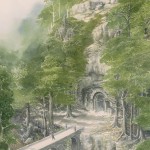 Many tales are sung by people of Menegroth, Menegroth the fair and Menegroth the great, Menegroth the thousand caves they call it. Many tales are sung by people of Menegroth, Menegroth the fair and Menegroth the great, Menegroth the thousand caves they call it. It is undoubtedly the greatest construction of the Sindar and it is said to be: “…the fairest dwelling of any king that has ever been east of the Sea.” Then it must be been a beautiful and wondrous monument indeed, for there are others that would vie for that claim and would not be wholly ousted from the coveted title. Not only for its beauty is Menegroth, the Mighty, legendary: many a great and historic people of the First Age had walked its many-pillared halls and some of them even lived there.
Many tales are sung by people of Menegroth, Menegroth the fair and Menegroth the great, Menegroth the thousand caves they call it. Many tales are sung by people of Menegroth, Menegroth the fair and Menegroth the great, Menegroth the thousand caves they call it. It is undoubtedly the greatest construction of the Sindar and it is said to be: “…the fairest dwelling of any king that has ever been east of the Sea.” Then it must be been a beautiful and wondrous monument indeed, for there are others that would vie for that claim and would not be wholly ousted from the coveted title. Not only for its beauty is Menegroth, the Mighty, legendary: many a great and historic people of the First Age had walked its many-pillared halls and some of them even lived there.
Number 2: Gondolin.
 Gondolin, the seven-named, and called Ondolindë (The Rock of the Music of the Water), Gar Thurion (Secret Place), Gondobar (City of Stone), Gondothlimbar (City of the Dwellers in Stone), Gwarestrin (Tower of the Guard), Gondost (Stone Fortress) was one of the most stunning piece of construction ever built by any race in Middle-earth. Indeed the tale “The Fall of Gondolin” is one of the oldest stories written about Middle-earth by Tolkien. It was built after the Dagor Aglareb, i.e some 100 years after the return of the Noldor, constructed by none other than Turgon, son of Fingolfin, son of Finwe.
Gondolin, the seven-named, and called Ondolindë (The Rock of the Music of the Water), Gar Thurion (Secret Place), Gondobar (City of Stone), Gondothlimbar (City of the Dwellers in Stone), Gwarestrin (Tower of the Guard), Gondost (Stone Fortress) was one of the most stunning piece of construction ever built by any race in Middle-earth. Indeed the tale “The Fall of Gondolin” is one of the oldest stories written about Middle-earth by Tolkien. It was built after the Dagor Aglareb, i.e some 100 years after the return of the Noldor, constructed by none other than Turgon, son of Fingolfin, son of Finwe.
Number 1: Khazad-dûm.
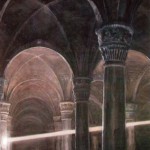 The greatest, grandest, mightiest, the most splendid, the most majestic, the largest, the most magnificent and most famous of all the work of the dwarves and perhaps of any race in Middle-earth is Khazad-dûm, the mansion of the Dwarves (according to me at least). Though it is not more beautiful than Menegroth, Gondolin or even Minas Tirith, in terms of size and magnificence it outstrips them all. Of all the seven wonders, it is the best described in the Lord of the Rings save Minas Tirith.
The greatest, grandest, mightiest, the most splendid, the most majestic, the largest, the most magnificent and most famous of all the work of the dwarves and perhaps of any race in Middle-earth is Khazad-dûm, the mansion of the Dwarves (according to me at least). Though it is not more beautiful than Menegroth, Gondolin or even Minas Tirith, in terms of size and magnificence it outstrips them all. Of all the seven wonders, it is the best described in the Lord of the Rings save Minas Tirith.


